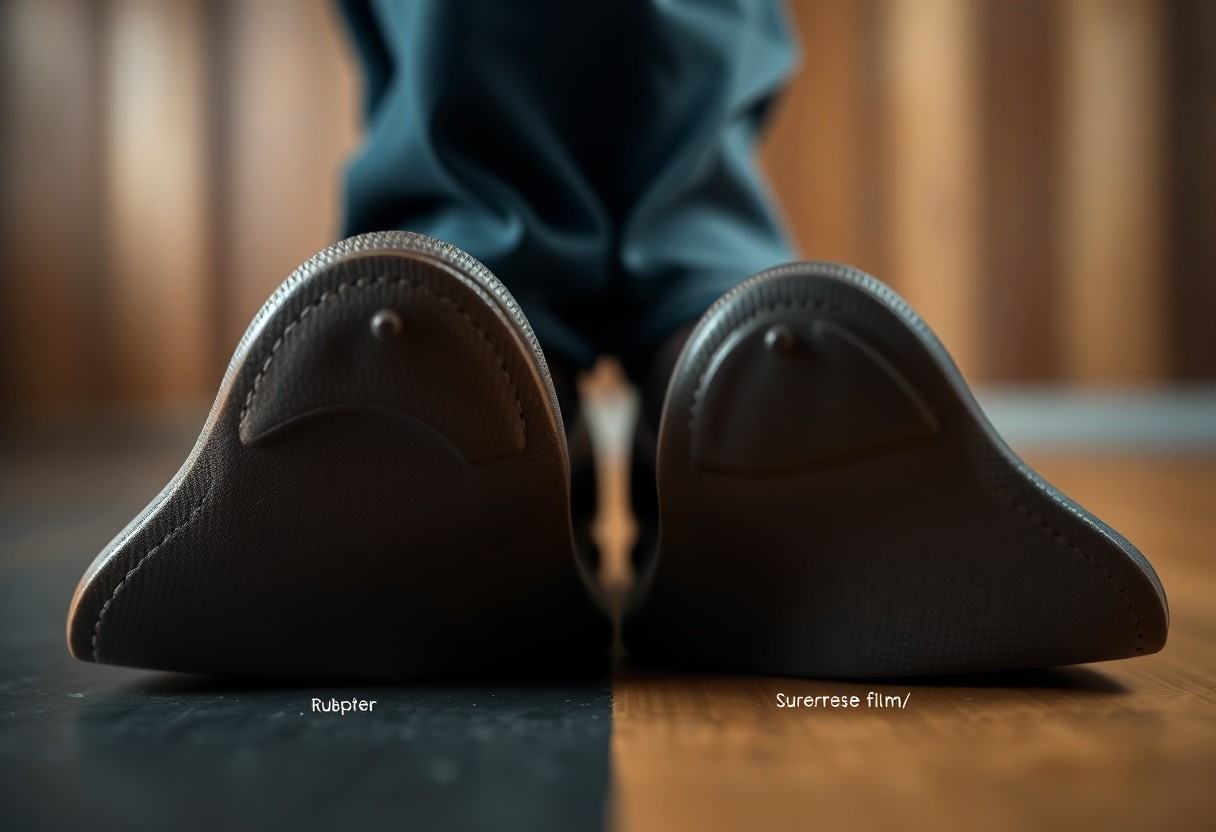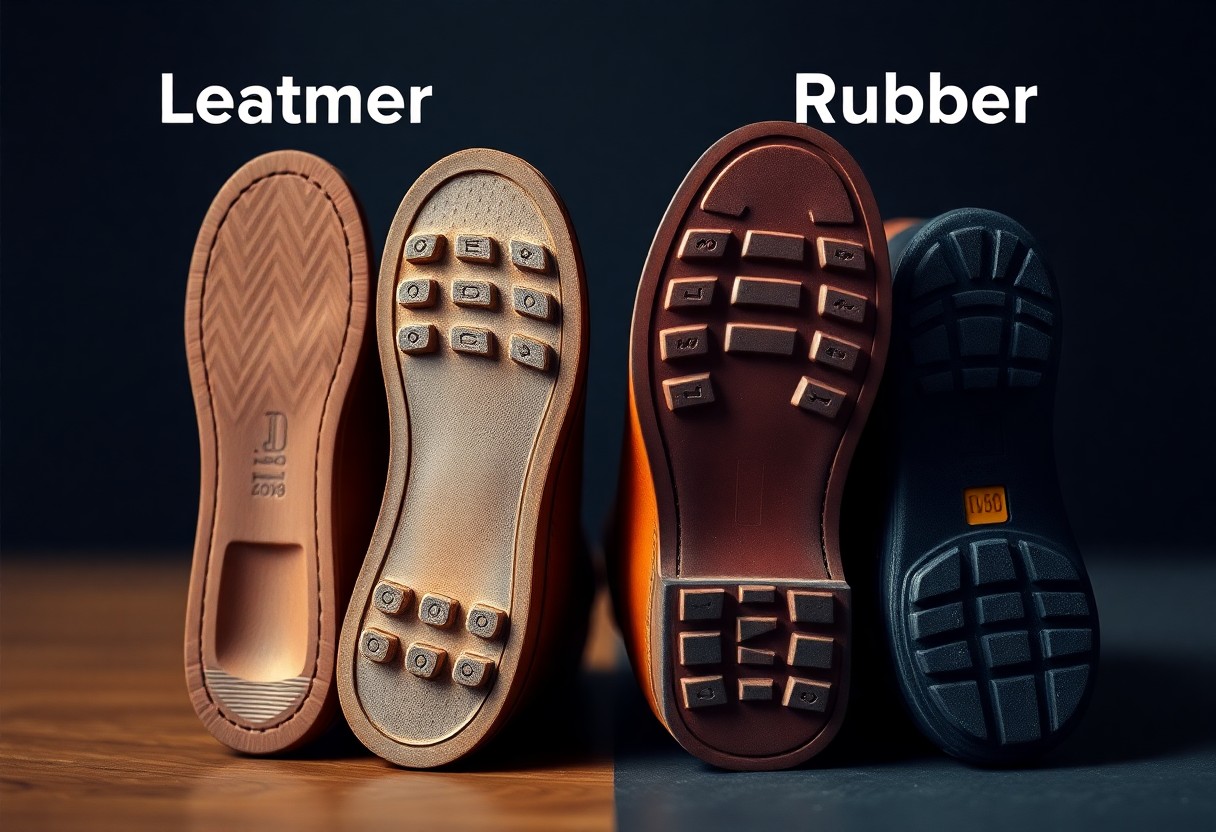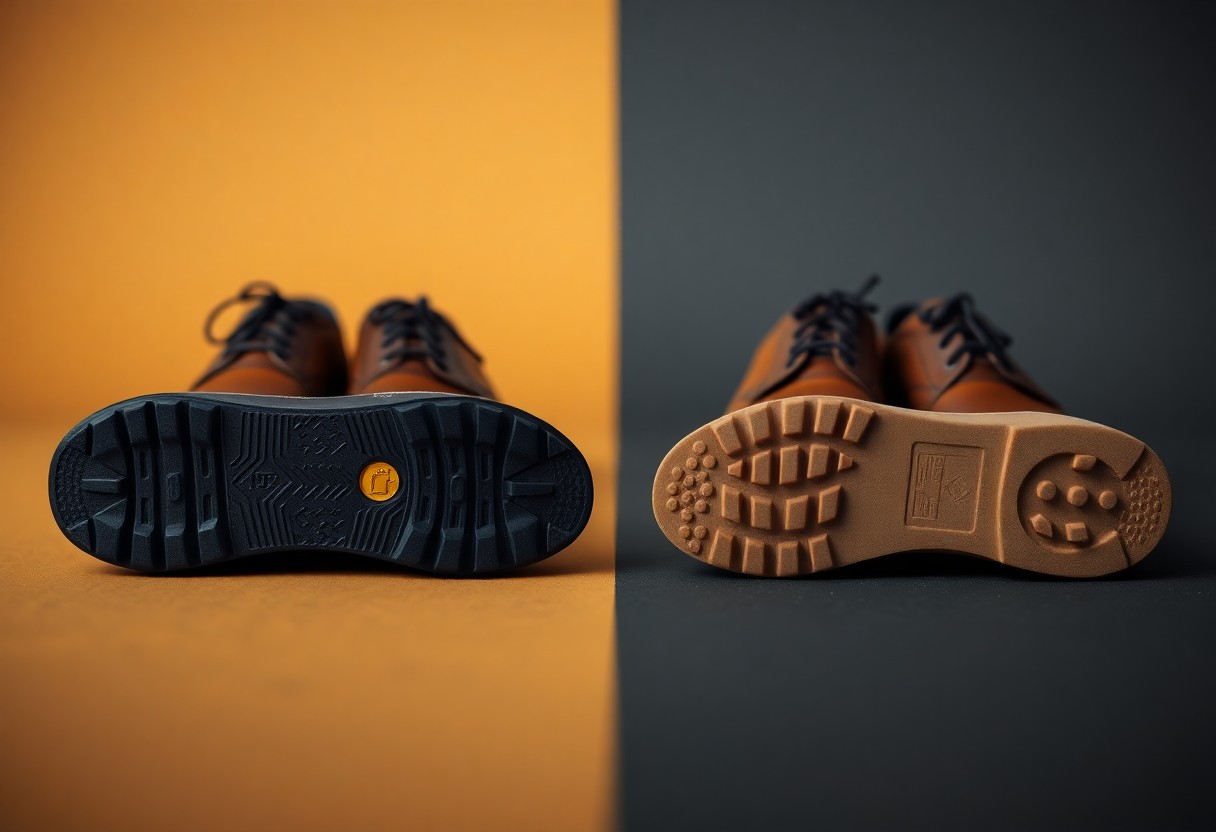When selecting new footwear, the decision between leather and rubber soles is crucial as it can significantly impact your comfort and overall walking experience. Leather soles offer superior breathability and adapt to the unique contours of your feet, providing a tailored fit over time. In contrast, rubber soles are celebrated for their outstanding grip and water resistance. Leather soles are often favored in formal settings and develop a distinct character with wear, while rubber soles deliver immediate comfort and enhanced traction, particularly in wet conditions. This in-depth guide will assist you in navigating the key differences between these materials, empowering you to choose the perfect sole option that aligns with your individual needs.

Discovering the Distinct Features of Footwear Sole Materials
Developing a comprehensive understanding of the different sole materials available is essential for making informed footwear decisions. Each material comes with its own set of unique benefits and disadvantages that can play a significant role in your daily comfort, the longevity of your shoes, and your overall satisfaction with your footwear. The choice between leather and rubber soles will not only affect your walking experience but also have implications for your foot health and the upkeep required for your shoes.
Unveiling the Advantages of Leather Soles for Footwear
For centuries, leather has been regarded as the traditional choice for premium footwear. Shoes designed with leather soles are crafted from natural materials that gradually conform to the shape of your feet, creating a custom fit that enhances comfort as you wear them. This material allows for excellent airflow, enabling your feet to breathe and adjust to varying temperatures throughout the day. With proper maintenance, leather soles can have a lifespan of 3 to 5 years under regular use, making them a worthwhile investment for those seeking durability and comfort.
Understanding the Key Benefits of Rubber Soles in Footwear
Rubber soles are renowned for their remarkable water resistance and immediate flexibility upon wearing. Shoes equipped with rubber soles provide exceptional grip on slippery surfaces and deliver effective shock absorption, ensuring they are comfortable right out of the box. This material maintains its shape and performance across diverse weather conditions, making rubber soles an ideal choice for daily wear and active lifestyles. Rubber soles demonstrate consistent performance even in challenging terrains, typically lasting between 2 to 3 years with minimal maintenance. While rubber excels in providing reliable traction and stability, particularly in wet or slick environments, it generally offers less breathability compared to leather options.
Understanding Comfort Factors Associated with Different Sole Materials
Recognizing how various sole materials influence your daily walking experience is vital for making the right choice. The decision between leather and rubber soles can dramatically impact your foot health and overall comfort. The ideal sole material should complement your walking habits, foot structure, and daily activities to ensure a satisfying and supportive fit.
Examining the Comfort Features of Leather Soles
The comfort provided by leather soles stems from their unique ability to naturally mold to your feet and their inherent breathability. Your feet benefit from several key aspects, including:
- Custom contouring, allowing the sole to adapt uniquely to your foot shape
- Natural air circulation that aids in keeping your feet dry and comfortable
- Cork layer cushioning that significantly enhances overall comfort
- Progressive softening that occurs with continued wear, increasing comfort
By grasping these features, you can make a well-informed decision that prioritizes long-lasting comfort and foot health.
Experiencing Immediate Comfort with Rubber Soles
Rubber soles shine in various weather conditions by providing instant comfort along with shock-absorbing capabilities. You will enjoy immediate flexibility with little to no break-in period, making rubber soles ideal for quick, on-the-go situations. The advanced technology behind rubber soles ensures superior grip and water resistance. Although rubber does not conform to your feet like leather does, it consistently provides excellent shock absorption and retains its shape, effectively protecting your feet from hard impacts. This makes rubber soles particularly suitable for extensive urban walking, enhancing your comfort in bustling environments.
Assessing the Durability of Various Sole Materials
When weighing the options between leather and rubber soles, it's essential to consider their different wear patterns and overall durability. Your walking habits and local weather conditions can significantly affect the lifespan of your soles. Both materials offer unique advantages regarding durability, but their effectiveness can vary considerably based on how they are used and cared for over time.
Exceptional Durability of Leather Soles
With proper care and maintenance, leather soles can deliver outstanding durability. When shielded from excessive moisture and outfitted with toe taps, leather-soled shoes can last anywhere from 3 to 5 years with consistent use. The quality of leather can be further enhanced through multiple layers; for instance, a triple leather sole may outperform many other options in terms of longevity. However, it is imperative to keep them dry and well-maintained to ensure their lasting performance.
The Robustness of Rubber Soles in Footwear
Rubber soles are well-known for their exceptional resistance to water and everyday wear. Shoes with rubber soles can withstand demanding conditions and typically last between 2 to 4 years under regular use. These soles excel on wet surfaces and require significantly less maintenance compared to their leather counterparts. However, it’s crucial to remember that the durability of rubber soles is influenced by the quality and thickness of the rubber compound used. High-quality rubber compounds can endure up to 8 years with proper care, while lower-quality versions may wear out within just a few months. Ultimately, your individual walking style and the frequency of use will dictate the actual lifespan of rubber soles.
Performance Evaluation of Sole Materials in Varied Weather Conditions
To make a well-informed choice regarding your footwear, understanding how different soles perform under various weather conditions is essential. Your decision between leather and rubber soles can significantly influence your comfort and safety in diverse weather situations. Each material offers unique advantages and limitations that affect their performance in wet, dry, or icy conditions.
Leather Soles Performance in Diverse Weather Conditions
Contrary to popular belief, leather soles may not be the most suitable choice for wet conditions. Water can severely damage leather soles, rendering them slippery. Leather performs exceptionally well in dry weather where it can offer excellent breathability. However, in wet conditions, leather soles can absorb up to 80% of their weight in water, leading to accelerated wear and potential damage to your footwear.
Rubber Soles Performance in Varied Elements
When comparing the two options, rubber soles provide outstanding grip and water resistance. You can confidently wear rubber-soled shoes in rain, snow, and on slippery surfaces, gaining the advantage of enhanced traction. These soles maintain their properties in temperature ranges from -10°C to 40°C, making them ideal for year-round use. A significant advantage of rubber soles is their remarkable water resistance and resilience in harsh conditions. They retain their shape and grip even after prolonged exposure to moisture, and their non-slip features significantly improve safety on wet surfaces, reducing your risk of accidents by up to 50% compared to leather soles.

Choosing the Right Style for Your Footwear
When it comes to style, not all sole materials are created equal. The choice of sole can profoundly influence the overall look of your shoes and their appropriateness for various occasions. While leather soles convey a polished and sophisticated aesthetic, rubber soles offer greater versatility for everyday wear. Your selection should align with your lifestyle and the intended purpose of your shoes.
The Timeless Aesthetic Appeal of Leather Soles
For formal occasions, leather soles remain the gold standard. They are commonly found in high-end dress shoes and formal footwear. The sleek profile and natural patina that develops over time enhance their aesthetic appeal. Your leather-soled shoes will present a refined edge and maintain an elegant silhouette that epitomizes classic footwear design, making them an ideal choice for special events and professional settings.
The Modern Versatility Offered by Rubber Soles
Currently, around 70% of modern shoes are designed with rubber soles. Your daily activities often require shoes that can adapt to a variety of surfaces and changing weather conditions. Rubber soles provide superior grip and weather resistance, making them well-suited for business casual environments and everyday wear. Additionally, it is noteworthy that contemporary hybrid options combine both materials, offering the best of both worlds. These innovative combinations deliver the elegance of leather along with the practicality of rubber. You can find dress shoes featuring thin rubber inserts or entire rubber soles designed to imitate leather, providing a balanced solution for your footwear collection.

Comparing the Cost of Sole Materials
Despite the initial price differences, your choice between leather and rubber soles impacts both short-term costs and long-term value. While leather soles may require more upkeep and occasional resoling, they can last 15 to 20 years with proper care. Rubber soles might provide better immediate value, but they often require complete replacement once they become worn.
Understanding the Initial Cost Investment
Typically, leather-soled shoes are priced approximately 20 to 30% higher than their rubber-soled counterparts. Investing in leather soles reflects the expense associated with high-quality materials and the expert craftsmanship involved in their creation. This higher initial cost often indicates superior construction techniques, such as Goodyear welting, which enhances durability and lifespan.
Long-term Value Assessment of Sole Materials
At first glance, rubber soles may seem to offer a more budget-friendly option, but leather-soled shoes can provide better value over time. With consistent maintenance and resoling, leather-soled shoes can last for decades, while rubber soles frequently require total replacement once they wear out. Although leather soles call for regular maintenance and resoling every 2 to 3 years, the costs associated with these services are generally lower than purchasing entirely new shoes. Your investment in leather soles yields dividends through their capability to be repaired and restored, a feature that most rubber soles lack once damaged.
Determining the Best Footwear Choice for Your Needs
Your choice between leather and rubber soles ultimately depends on your individual preferences and lifestyle. Leather soles offer superior moldability and sophistication, making them an ideal selection if you desire shoes that adapt to your feet while projecting a classic appearance. Conversely, rubber soles provide immediate comfort and excellent water resistance, making them particularly suitable for those who often navigate wet conditions. Consider your walking habits, local climate, and personal comfort preferences, as these factors will play a crucial role in guiding your decision. Both types of soles are valuable additions to a well-rounded footwear collection, allowing you to choose based on the intended use for each pair.
Answers to Common Questions About Sole Materials
Q: What are the comfort differences between leather and rubber soles?
A: Leather soles gradually conform to your feet, creating a personalized fit that improves comfort over time. They perform optimally when paired with cork filling and proper arch support. Conversely, rubber soles deliver immediate flexibility and superior shock absorption but do not mold to your foot's shape. While leather tends to provide better all-day comfort once broken in, rubber may feel comfortable initially but can lead to foot fatigue during prolonged wear.
Q: How do leather and rubber soles compare regarding durability and weather resistance?
A: Double or triple leather soles with toe taps can last many years with appropriate care. However, single leather soles wear out more quickly and are more susceptible to water absorption. Rubber soles excel in water resistance and handle rough surfaces effectively. They require less maintenance and perform better in wet conditions. Ultimately, your choice should be based on your walking environment and frequency of use.
Q: Which type of sole should I choose based on my requirements?
A: Opt for leather soles for formal attire and office wear, especially if most of your activities take place indoors. They provide enhanced breathability and sophistication. Alternatively, select rubber soles for daily commuting, frequent outdoor walking, or rainy weather. Factor in your walking surface—leather performs well on carpeting and smooth floors, while rubber excels on rough pavements and wet surfaces.
The Article Leather soles vs rubber soles key differences benefits and how to choose the right one appeared first on My Shoes Finder
The Article Leather Soles vs Rubber Soles: Key Differences and Benefits Was Found On https://limitsofstrategy.com


Comments are closed